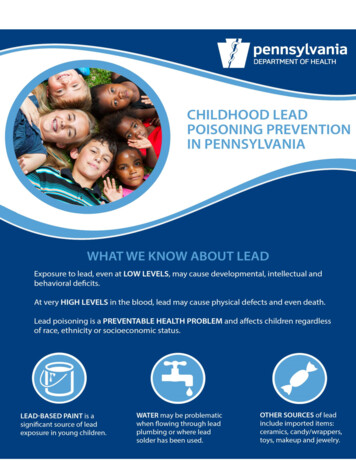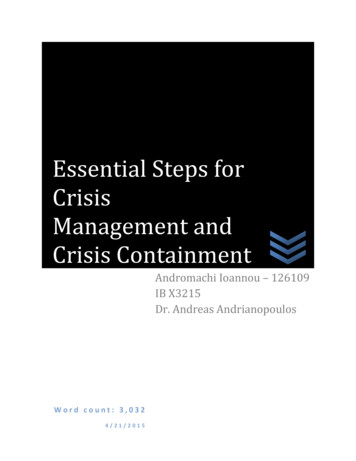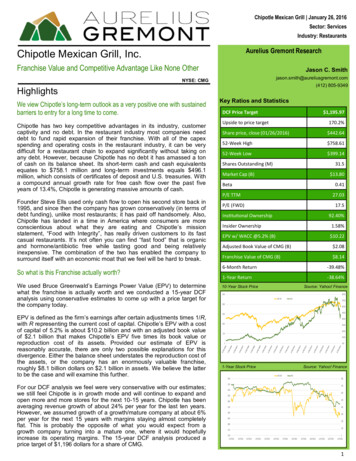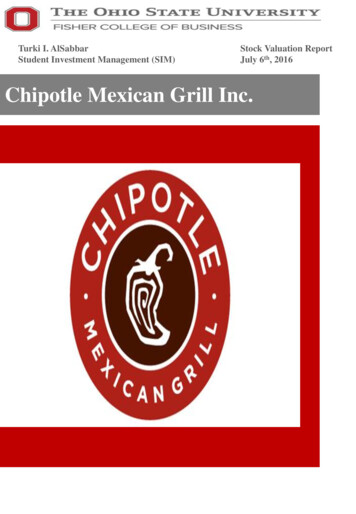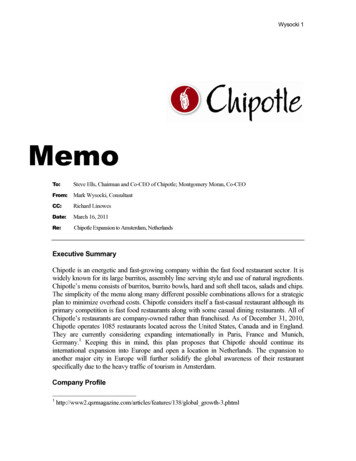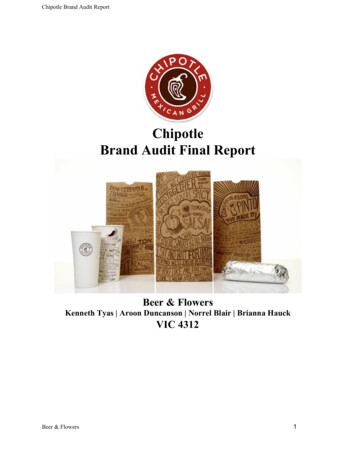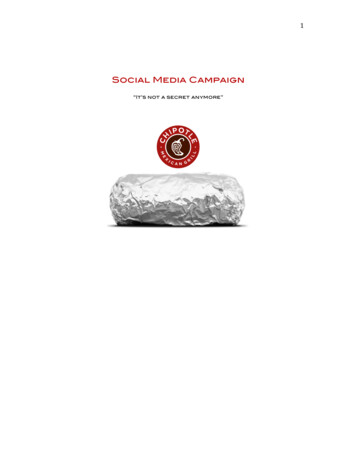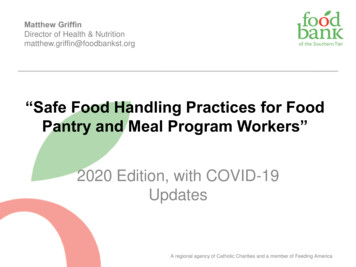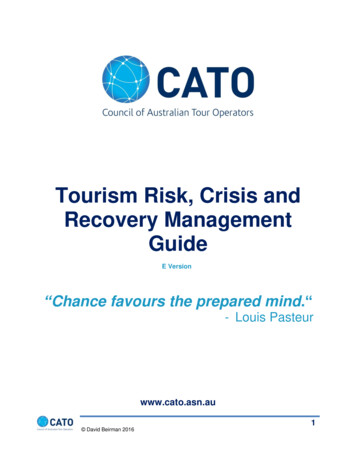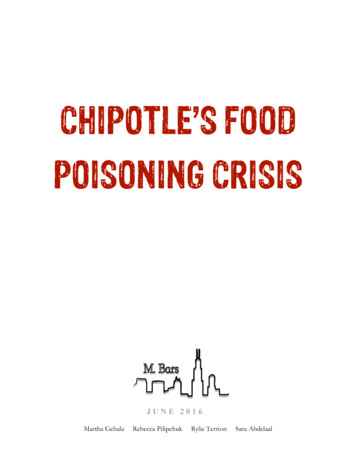
Transcription
CHIPOTLE’S FOODPOISONING CRISISJUNE 2016Martha GebalaRebecca PilipchukRylie TerrionSara Abdelaal
2Executive SummaryStudy Background and Purpose:A recent E. coli outbreak across the Chipotle chain made national headlines in 2015. Since then,Chipotle, known for their steady success and popularity, took a 36% hit in sales. The nowcontained outbreaks caused a major blow to the brand. How does a company recover frombacteria outbreaks? How can they bring their once-loyal customers back?M. Bars Market Analytics conducted several studies to determine how millennials, Chipotle’starget audience, feel after the outbreaks and how we can best satisfy them as consumers.Methodology:To answer these questions, we gathered both qualitative and quantitative data. We performed aseries of one-on-one, in-depth interviews. Our interviewees were selected by convenience andjudgement sampling in order to target our consumers, millennials. Our interview questions weredesigned to target interviewee’s opinions on Chipotle’s brand, their likelihood of returning afterhearing about the outbreaks, and who Chipotle’s biggest industry threats are.We also conducted a survey on Qualtrics. Shared by M. Bars market analyzers via social media,the responses were non-random convenience samples. With over 80 responses we were able toanalyze respondent’s opinions on the same research questions used in the in-depth interviews.Main Findings:Through both our qualitative and quantitative research, we found that the E. coli crisis has notdeterred majority of Chipotle’s target audience, millennials. We also found that millennials areinterested in seeing Chipotle expand menu options, both in price and variety. Our respondentsand interviewees also expressed that Chipotle’s main competitors are fast food restaurants thatoffer cheaper menu options such as the Dollar Menu (McDonald’s) and You Pick Two(Subway).Conclusion and Recommendations:Our findings, although conclusive, would be better tested on a larger scale. More surveyrespondents over a larger area would increase the validity of the results. We recommend a QRcode-based survey printed on the bottom of Chipotle receipts. This both targets consumers and iscost effective. Likewise, focus groups would be another effective method of gaining deeperinsight to consumer behavior and thought.
3Table of ContentsExecutive Summary .2Situation Analysis .4-9Introduction .4Background .4-6The Issue .4-5The Company .5-6SWOT Analysis .7-8Strengths .7Weaknesses .7-8Opportunities 8Threats . .8Information Needs . .8-9Interview Report .9-10Topic and Research Goals .9Justification and Method Sampling .9Interview Highlights .9-10Insights .10Research Questions, Revisited .10Survey Report 10-15Research Topic .10-11Research Questions .11-12Plans .12-13Analysis .12-14Bivariate Data Analysis 14Discussion 14-15Recommendations for Further Research .16-17Further Data Collection Plans .16-17Works Cited .18-19Appendix .20-26Revised Interview Guide .19-23Revised Survey . 23-26
4Situation AnalysisIntroduction:Chipotle Mexican Grill, Inc. is an American chain of fast food restaurants that focuses on servingfood sourced from sustainable farming practices. Since its establishment in 1993, Chipotle hasbecome a sensation within the restaurant business. It has faced incredible growth since thecompany went public in 2006. A lot of the firm’s success can be credited to the consumer base.M. Bars, our research group, is working alongside Chipotle to gain deeper insight into theconsumer’s mind. We looked at Chipotle’s target audience, millennials, to delve deeper into theirthoughts on Chipotle as a brand; their loyalty, their opinions on the recent outbreaks, andChipotle’s position in the fast-casual restaurant chain industry.Background:The IssueSince the summer of 2015, Chipotle has been suffering their first major decrease in salesdue to two recent E. Coli outbreaks throughout the chain. Escherichia coli, more commonlyknown as E. coli, is a germ that normally thrives in the intestines of humans and animals. Themost common source of E. coli germ is found in beef; to be exact, 55% of the cases are found inthis source. 21% is found in raw vegetables, 11% in raw milk and cheese, and 65% in othermeats and poultry. Many E. coli are harmless and actually contribute to a healthy humanintestinal tract. But there are six types of E. coli that cause illness. Not all STEC infections arediagnosed though due to the fact that many people do not seek medical help when symptomsoccur. (Porjes 27).Realizing that someone has been affected by STEC, or Shiga toxin-producing E. coli, isnot immediate. People usually see signs and symptoms about 2-8 days after consuming the foodthat has been contaminated with the germ. Diarrhea, oftentimes bloody, and abdominal crampingare the most common symptom. Recovery usually lasts about a week. In some cases, the illnesslasts longer and can have more serious side effects, potentially resulting in hemolytic uremicsyndrome, which is a type of kidney failure. Fever, abdominal pain, pale skin tone, bruising orbleeding on the face, and fatigue are some common symptoms of this syndrome. Anyone can getinfected by E. coli, regardless of age. But very young children and the elderly have a higherchance of this. In the Chipotle E. coli outbreak, the youngest infected was 1-year-old and theoldest was 67. (“FDA Investigates”)In November of 2015, 43 Chipotle restaurants were closed in Washington and Oregon asa result of the initial E. coli outbreak. Chipotle consulted and collaborated with health officialsduring the investigation to figure out whether it was acceptable to re-open these locations. Theydid so later that month. However before doing so, Chipotle reported to have taken a series ofsteps in order to make sure all health regulations were met. This was an intense process; itincluded actions such as expanding testing of fresh produce, raw meat, and dairy items prior toarriving at the restaurant locations, and working with federal, state, and local governmentagencies in executing additional safety procedures and audits in all 2,000 (approximate)restaurants to make sure that all food safety standards are in place. Over 2,500 tests were donetesting Chipotle’s food, restaurant surfaces, and equipment. All employees were examined forthe possibility of the illness before returning to work. (“FDA Investigates”)
5Because of the food-poisoning outbreaks, Chipotle has suffered some major financialdamage. Overall, Chipotle has been accused of five separate food poisoning outbreaks during theyear 2015. Between October and November of 2015, the company was connected with two foodpoisoning outbreaks. The remaining three outbreaks did not receive as much publicity andattention as the last two. 64 people in Minnesota were infected by Salmonella in August.Approximately 294 cases were reported for norovirus in California’s Simi Valley during thesame month. And in July, an outbreak of a different type of E. coli infected 5 people in Seattle.It was reported that an E. coli outbreak in October-November had a 16% sales decline in thestore that it occurred in. The company’s stock is now 30% less than the record high it just set inAugust of 2015. In December of 2015, 80 Boston College students reported to have stomachpains after consuming Chipotle. It was found that this was the most popular type of foodborneillness – norovirus. Due to this, that Chipotle restaurant in Boston was closed down. In total,Chipotle’s E. coli issue has negatively affected over 350 people across the country. BenjaminChapman, an Associate Professor and food-safety specialist at North Carolina State Universitystated “It’s off to see so many issues at one chain. It’s not very common to see outbreaks linkedto the same place, the same brand, in a couple of months with different issues. It does make youwonder how they’re managing food safety as a whole.” (Porjes, 93)In the wake of these food safety illnesses, the media has not been very kind towardsChipotle. Consumer perception of the brand has also dramatically worsened. In order to aid inthe prevention of future outbreaks of foodborne illnesses, Chipotle has been working withseveral food safety consultant firms to assess and recover its already high standards for foodsafety. It is also encompassing higher standards for food suppliers. Chipotle will also start usingDNA-based tests instead of just trusting suppliers to test for potential contamination. The chainwill heighten and improve internal training make certain that all employees completelyunderstand Chipotle’s food safety and handling standards. Future sales trends may besignificantly affected by these improvements and progresses. (Porjes, 94)On February 1, 2016, the Centers of Disease Control and Prevention (CDC) announcedthat the E. coli outbreak linked to Chipotle Mexican Grill appears to have concluded (“FDAInvestigates”). Nevertheless, it is thought that this may be a major crisis for Chipotle, since it is abrand that has centered on a promise of clean and safe food for years.The CompanyChipotle is in “the business of good food” (Chipotle Mexican Grill, Inc.) and it is payingoff. Chipotle is a fast food option that is taking over the United States. Since 2006, the number ofChipotle restaurants in this country has almost doubled, and as of last year, Chipotle has tripledits revenue to 2.3 billion (Stein).Chipotle is a Mexican style restaurant. It is a more organic and natural option comparedto fried, preserved food like McDonalds. From the very start, Chipotle used quality ingredientsthat were raw, and cooked them with technique, rather than mass-producing (Chipotle MexicanGrill, Inc.). Chipotle “brought features from the realm of fine dining to the world of quickservice restaurants” (Chipotle Mexican Grill, Inc.).Chipotle opened its first restaurant in 1993, with a simple goal, to show that “food servedfast didn't have to be a ‘fast-food’ experience” (Chipotle Mexican Grill, Inc.). “We're all aboutsimple, fresh food without artificial flavors or fillers. Just genuine raw ingredients and theirindividual, delectable flavors. We source from farms rather than factories, and spend a lot moreon our ingredients than many other restaurants. We wouldn't have it any other way” (ChipotleMexican Grill, Inc.).
6More than twenty years has passed since the world’s first Chipotle, and the brand hasn’tchanged. Chipotle has devoted its brand to “finding the very best ingredients they can—withrespect for animals, farmers, and the environment—is shown through our Food with Integritycommitment” (Chipotle Mexican Grill, Inc.). As Chipotle grew, they extended their mission tocreating an exceptional experience for their customers. They claim the exceptional experience is“the natural result of cultivating a culture of genuine, rewarding opportunities for ouremployees” (Chipotle Mexican Grill, Inc.).“[Chipotle’s] goal is to destroy fast food: no more frozen patties, no more microwaves, no morefactory farms (Stein). The employees at Chipotle actually cook. Although this causes some variety in tasteof the food, it is a much healthier option to greasy foods. “Chipotle uses locally grown produce wheneverpossible,” and the beans used are both organic and no-till (Stein). No-till beans do less damage to the soil,making them an even better option than merely organic beans. “Last year, Chipotle used 10 million lb. oflocally grown avocados and other produce,” “All the sour cream (and 65% of the cheese) comes frompasture-raised cows,” “The carnitas comes from pigs that can roam outside or in deeply bedded pens”(Stein).Chipotle’s website has a section dedicated to informing their customers. One can visit thesite and click the “Food With Integrity” tab to find out about the food’s preparation and thecompany. Under the tab, one can learn about the “whole or nothing” ingredients, the chefs, thelivestock’s’ environment and the outcome of using healthy livestock. The fact that Chipotle has adesignated section on their website to inform their customers is something that sets them apartfrom many other fast food alternatives. They are not hiding their ingredients or their methods.Chipotle has a reputation for informing their customers. Typically, Chipotle uses locallygrown, pasture-raised meats. However, occasionally that is not attainable due to livestockshortages. If any type of meat being served at Chipotle is not 100% locally grown and pastureraised, there is a sign posted on the bar. The sign informs customers that a specific meat may notbe grass-fed or from local farmers. Signs are also posted if the restaurant is out of an ingredientor if it has changed a recipe. For instance, Chipotle changed the recipe for pinto beans and posteda sign stating “We’ve created a new pinto bean recipe that no longer contains bacon, but is stilljust as delicious. So vegetarians, vegans, and the bacon-adverse, rejoice. Omnivores, enjoy themas you normally would” (Renneisen). The signs that Chipotle posts helps keeps customers up todate, and makes the fast-food experience faster and more convenient.“Cultivating a better world” (Chipotle Mexican Grill, Inc.) is what Chipotle has set out todo. They are trying to redefine fast food with a healthier option. Between natural ingredients, andkeeping the customers informed, the foundation of the Chipotle brand is that it is a healthieroption, and a fast-food company that differs from all other fast-food brands.
7SWOT Analysis:Strengths Efficiency at both the corporate level andindividual chain level Many restaurants with healthy revenue Sustainably sourced food Millennial target audience andnontraditional marketingOpportunities Improve health standards publicly Millennial-geared marketing efforts Expand the menuWeaknesses E. coli and other food safetyrelated outbreaks Closing of stores by healthofficials Decline in revenue due tooutbreaksThreats Many competitors Cost to customer compared toother fast food optionsStrengthsChipotle doesn't franchise. This allows for better quality control because it operates under onesingular corporate. The assembly line-style of the restaurants not only allows customers tocustomize every aspect of their meal, it also allows for increased efficiency. Increased efficiencynot only cuts down on costs, but also increases customer satisfaction. Another positive attributeis the amount of stores, in 2014 chipotle had over 1,700 stores in the US. This is not includingthe 16 international restaurants. This shows that Chipotle is widespread and therefore reaches alarge target audience. Another strength is Chipotle’s revenue. On average, each location brings inapproximately 2.2 million a year. Coupled with a projected store growth of up to 7,000worldwide, there is a large margin for profit (Simpson). Financial stability and positivepredicted growth as a company is a great strength. Chipotle, as a corporation, prides itself onserving “food with integrity”. Chipotle only serves naturally raised chicken, pork and 60% of it’sbeef is naturally raised. Chipotle only uses zero trans-fat frying oil and does not use cheese orsour cream with rBGH. In addition, 40% of Chipotle’s black beans are certified organic(Simpson). Chipotle recognized that consumers valued their own health and the well-being ofanimals so invested into the idea and eventually made it a pillar of their corporation. Anotherstrength that Chipotle utilized and continues to utilize non-traditional marketing methods toreach millennials. They utilize social media and are engaged on college campuses. Through theirmarketing, they offer millennials fun promotional events such as their annual Halloweenspecials, or interactive games resulting in free food.WeaknessesChipotle’s largest weakness is the recent E. coli outbreak. In the fall of 2015, 43 restaurants inthe pacific northwest were closed and liked to an E. coli outbreak throughout six regionalrestaurants. Then more cases of E. coli were reported throughout seven more states (Edmund).Norovirus and salmonella poisoning were also reported (Sifferlin). These outbreaks set off achain of events that included health authorities shutting down numerous restaurants and evenChipotle taking a corporate-wide meeting day that involved all restaurants to close for a periodof time. The recent E. coli outbreaks, although now under control were very detrimental to the
8public’s view of Chipotle. Chipotle experienced a 36% decline in stock post-outbreak. Thisequates to a loss of at least 1 per share (Gensler).OpportunitiesIn light of the E. coli outbreak, Chipotle has hired IEH Labs to help improve health standardsand produce-testing. This is an opportunity that Chipotle could take advantage of. If theypublicized their new cleanliness standards than people would feel safer coming back to the chain.Chipotle also should utilize millennial-targeted marketing. In February of 2016, Chipotle ran afree burrito promotion which lessened their post-outbreak decline by about 10% (Gensler).Chipotle also has great opportunity with expanding their menu. Although there are thousands ofpossible meal combinations, competitors such as Qdoba offer items such as nachos and a varietyof dips.ThreatsChipotle faces many competitors. Not only from similar companies like Qdoba or other Tex Mexchains, but from other fast-food corporations. Their largest threats come from Rubio’sRestaurants, Brinker International, Panda Restaurant Group, Carrols Restaurant Group, BJ’sRestaurants, Burger King Worldwide, Yum! Brands, Fiesta Restaurant Group, and Jack in theBox. These are threats because some of the restaurants under these corporations have a betterhold on the market and a stronger presence. These businesses also sell food at lower prices andoffer value menu options.Information Needs:Our team still needs more information of the opinions of customers towards what kind ofstrategies would be effective in order to bring customers back to Chipotle after the crisis. Due tothe damage done to their reputation by the E. Coli scandal, we want to know if Chipotle will beable to recover. Based on Chipotle’s past reputation and good standing with the public, and thevarious tactics they have tried to revive their business and reputation, will Chipotle goers gainback their loyalty to the brand? This information can be gathered through focus groups withmembers of our target market to learn more about their attitudes and reactions to Chipotle’scrisis; and large-scale surveys to gain a broader picture of the effect of the promotions atChipotle. We will use similar questions that we have used in our survey and interviews, however,we will change the wording a little bit and add some perks to spice it up. Overall, the researchwill reflect the effect of these promotions on consumer attitudes and whether they have a positiveor negative effect on Chipotle’s sales.Large-scale survey researching customer opinion of Chipotle as a brand How do customers feel after eating Chipotle? Does the crisis prevent a customer from buying Chipotle? Every respo
M. Bars Market Analytics conducted several studies to determine how millennials, Chipotle’s target audience, feel after the outbreaks and how we can best satisfy them as consumers. Methodology: To answer these questions, we gathered both qualitative and quantitative data.
